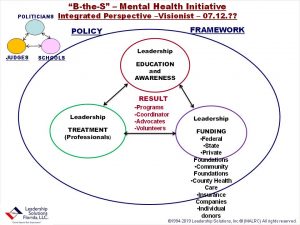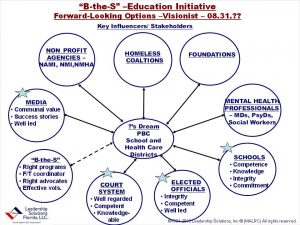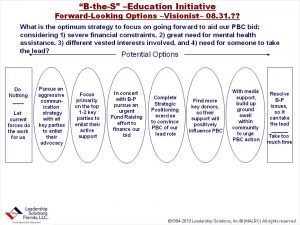by Peter A. Arthur-Smith, Leadership Solutions, Inc.®
‘The primary organization differences between not-for-profit and for-profit enterprises are: the former naturally creates good will, relies on volunteers and breaks-even; while the latter aims to create goodwill, relies on full-time staff and makes a taxable profit. In all other ways they should operate in the same way.’ – The author
 |
A number of years ago this writer found himself with a small band of volunteers in Florida, who eagerly wanted to address a growing Mental Health Crisis. In today’s environment of mass shootings that particular meeting was most prescient. However, at that time, they were challenged to exercise their minds on how to develop a coherent public response toward addressing growing mental health issues at all levels of society.
The adjacent paradigm was the culmination of several months of deliberation among concerned volunteers to build a substantial movement to address the situation. It articulated a three-pronged approach toward making some progress. They appreciated it would take leadership more than management, in a concerted three pronged effort, to make a substantial difference. These included:
» Educating politicians, judges and schools on addressing mental health issues, as early as possible in a person’s life, in order to head-off potential consequences.
» Ensuring the right treatment and professionals are available to help those in need.
» Generating the funding necessary to treat people and educate community influencers until the issue becomes manageable.
 |
Such a three point strategy was built from identifying the primary factors that would influence the overall RESULT: such as the right programs, having a full-time coordinator working with the Visionist(volunteer leader), the right advocates, and a good number of effective volunteers. These were all part of their framework to build an organizational vehicle that would then require constant fueling through enlightened leadership.
One element to fully understand all the forces influencing the outcome is the adjacent picture of every stakeholder – primarily external – involved. It also included the input, additional funding and catalytic force B-the-S could provide to encourage maximum participation and forward momentum. It had already defined an inspiring purpose, which was:
‘To identify, prioritize and take action to promote and support education, early identification and access to mental health services.’
An important step in mapping out this stakeholder picture was to clarify the top 50% priority constituents. Such a move avoided trying to be all things to all constituents. It also helped sharpen this non-profit’s message and value proposition: all things important in a business situation, too. Additionally, they itemized the factors that would be important to those priority stakeholders, which also enabled them to further refine their message and value.
Your next challenge as a non-profit Visionist with a team of volunteer Strategists is to figure out your order of approach – as this earlier volunteer team had to do – which is where the below Option Solving paradigm came in handy. This required their team to ask a pointed question to spark some objective thinking: “What is the optimum strategy to focus on to aid our PBC bid; considering 1) severe financial constraints, 2) a great need for mental health assistance,
 |
3) so many different vested interests involved, and 4) need for someone to take the lead?”
The bid they referred to was making a formal request to their local county to get funding for mental health services. This would be outside B-the-S’s own private fundraising efforts. Using option solving requires establishing ‘bookends’ to focus a team’s enormous creative capacity when drawing upon their intuitive capabilities – learn more through www.optionsolving.com Their chosen bookends were the least likely options they would be pursuing.
From there, you can see their six possible options which they could pursue. With the OS technique you would then set some time aside – an hour, 2 hrs or first thing the following morning– to allow your team’s intuitive minds to subconsciously
reflect upon such arrange of options. At that later moment, participants can then quickly scan this pictograph to refresh their memories and then make their choice. The majority votes get the call; at which point the team will put together an action initiative to fully take advantage of that choice. This activity is known as drawing upon the “Wisdom of the crowd.” Second guessing yourselves is not a good idea, since it will muddle your thinking and interfere with your extraordinary intuitive capabilities: which are more likely to be right than wrong.
With a clear idea of its intentions and priorities using these enlightened leadership tools, this not-for-profit was well positioned to move forward and gain momentum within its community. It then utilized the prescribed Simple Success Strategy to maintain focus and build support for its efforts:
» Pursue their compelling Vision, Purpose and Strategy for an optimum outcome.
» Gather and motivate the right group of volunteers around them.
» Become an Enlightened Leader team in order to fully engage their team until their outcome is surpassed.
As a non-profit, it has moved on to provide valuable leadership on mental health issues within its community. Their challenge was getting the whole initiative started in the right way and then build a positive volunteer team to lead their efforts. Since there’s always likely to be a certain amount of people-change over time within volunteer leader teams, dependent on people’s personal commitments; it’s important to find replacements within enlightened leader teams where new members have the right attributes for a Visionist, Expansionist, Innovationist, Provisionist, Operationist, Promotionist or Humanist role: more about these in the author’s forthcoming book – ‘Radical Leadership Breakthrough: Embracing the Five Phases of Enlightened Leadership.’
One way of doing this, is to invite retiring members to help identify and recruit their replacements, since people readily identify with others similar to themselves. Assuming there is positive good will with their retirement, which is normally the case with enlightened leader teams, the right replacement should fairly readily emerge. You will then have similar success to “B-the-S’s” in launching your valuable community not-for-profit.
To learn more about envisioning and decision clarity, talk with:
